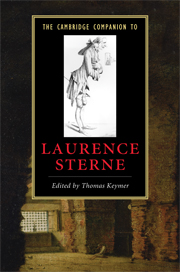Book contents
- Frontmatter
- Introduction
- 1 Laurence Sterne’s life, milieu, and literary career
- 2 Scriblerian satire, A Political Romance, the ‘Rabelaisian Fragment’, and the origins of Tristram Shandy
- 3 Tristram Shandy, learned wit, and Enlightenment knowledge
- 4 Tristram Shandy and eighteenth-century narrative
- 5 The Sermons of Mr. Yorick: the commonplace and the rhetoric of the heart
- 6 A Sentimental Journey and the failure of feeling
- 7 Sterne’s ‘politicks’, Ireland, and evil speaking
- 8 Words, sex, and gender in Sterne’s novels
- 9 Sterne and print culture
- 10 Sterne and visual culture
- 11 Sterne and the Modernist Moment
- 12 Postcolonial Sterne
- Further reading
- Index
- Series List
6 - A Sentimental Journey and the failure of feeling
Published online by Cambridge University Press: 28 January 2010
- Frontmatter
- Introduction
- 1 Laurence Sterne’s life, milieu, and literary career
- 2 Scriblerian satire, A Political Romance, the ‘Rabelaisian Fragment’, and the origins of Tristram Shandy
- 3 Tristram Shandy, learned wit, and Enlightenment knowledge
- 4 Tristram Shandy and eighteenth-century narrative
- 5 The Sermons of Mr. Yorick: the commonplace and the rhetoric of the heart
- 6 A Sentimental Journey and the failure of feeling
- 7 Sterne’s ‘politicks’, Ireland, and evil speaking
- 8 Words, sex, and gender in Sterne’s novels
- 9 Sterne and print culture
- 10 Sterne and visual culture
- 11 Sterne and the Modernist Moment
- 12 Postcolonial Sterne
- Further reading
- Index
- Series List
Summary
It was Tristram Shandy that propelled Sterne to fame, and his reputation centres today on the virtuoso combination of erudite, transgressive wit and playfully disrupted textuality for which 'Shandean' remains our shorthand term. In the decades following his death, however, Sterne was celebrated above all for A Sentimental Journey through France and Italy, and in Britain, Europe, and North America, editions of this later, shorter work outnumbered reprints of Tristram Shandy well into the nineteenth century. Overarching trends and local contingencies combined to shape this episode in the history of taste. In the first category was an increasingly dominant culture of politeness and sensibility in which Sterne's Rabelaisian side was deplored while his focus on sympathy and benevolence gained prestige; in the second, Sterne's death just weeks after publishing A Sentimental Journey, which irresistibly dramatised the pathos of the work, and the damage done to Tristram Shandy by John Ferriar's allegations of plagiarism in the 1790s, which left the Journey relatively unscathed. Cultural change and individual initiative can both be seen at work in The Beauties of Sterne (1782), an enterprising compilation by the young William Holland, later a fashionable publisher of satirical prints, which exploited the recent collapse of perpetual copyright by reprinting affecting extracts from the novels, 'selected', Holland's subtitle declares, 'for the heart of sensibility'. More than any other, it was this mawkish volume that fixed Sterne's reputation as the genius of the sensibility vogue.
- Type
- Chapter
- Information
- The Cambridge Companion to Laurence Sterne , pp. 79 - 94Publisher: Cambridge University PressPrint publication year: 2009
- 2
- Cited by

